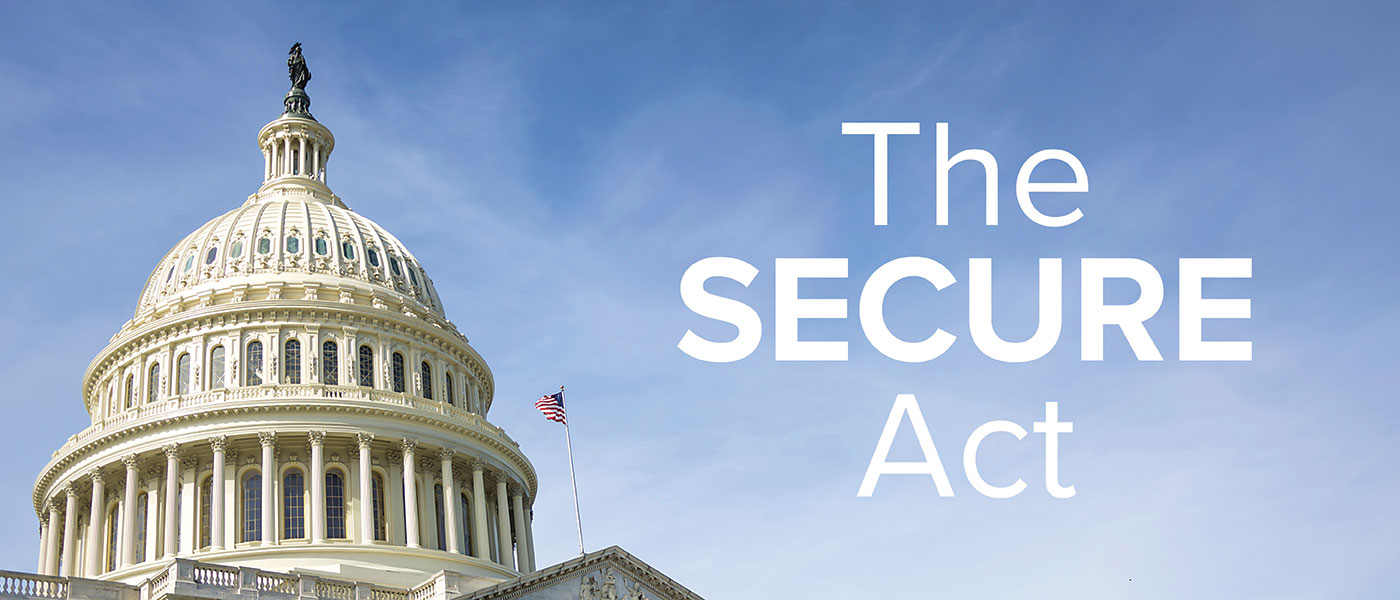
The Pentera Blog
The SECURE Act and How It Affects Charitable Planning
New legislation designed to help make sure that you don’t outlive your assets in retirement has implications for charitable planning, including the popular IRA rollover gift.
The law:
- Raises the age at which you must start receiving retirement distributions from 70½ to 72.
- Allows contributions to be made to a regular IRA after the age of 70½.
- Requires (with certain exceptions) that retirement funds given to nonspousal beneficiaries be fully distributed within ten years.
The official title of the legislation is “Setting Every Community Up for Retirement Enhancement Act of 2019,” popularly known as “the SECURE Act.” It was signed into law by the president on December 20. Most of the provisions become effective in 2020.
General Provisions Enabling More Retirement Security
For a large number of Americans, their retirement-plan accumulations plus personal savings will not be adequate for a financially secure retirement. This legislation takes a step towards addressing that problem by providing greater access to tax-advantaged retirement plans—helping to prevent older people from outliving their assets.
Many small businesses do not offer a retirement plan to employees because of the cost and complexity. The Act simplifies the process and reduces the cost with a credit to employers who create a 401(k) or SIMPLE IRA plan with automatic enrollment.
Under previous law, employers could generally exclude part-time employees (those who work less than 1,000 hours during the year) from enrollment in a company plan. The Act makes it easier for part-time workers to participate.
Many health care workers could not contribute to a retirement plan because their compensation is not construed to be qualifying income. The Act defines their income in a way that qualifies them for participation.
Students often graduate from college with a heavy debt burden, and sometimes money remains in a 529 account established for their education. The Act allows usage of money in a Sec. 529 account to be used, up to $10,000 annually, for debt repayment of qualified student loans.
The Act permits penalty-free withdrawals from retirement plans for a qualified birth or adoption distribution.
For liability reasons, it has been difficult to include annuities as an option in workplace plans. The Act deals with the liability issue.
These are only some of the numerous provisions of the Act. For more information about how you might be affected or about opportunities that may now be available to you, contact your employer and/or your tax advisors.
Provisions That May Also Have Implications for Charitable Planning
Here are details on the three provisions that could affect charitable as well as general estate planning.
1. The Act raises the age at which you must start receiving distributions from 70½ to 72.
This applies to regular IRAs and also to certain other plans. However, a person who is enrolled in one of these other plans and is still working may be able to delay the mandatory distributions, subject to conditions of the plan.
Raising the age for the start of mandatory distributions was stimulated by the fact that people are living longer and retiring later. If you can invest your retirement funds on a tax-deferred basis for a longer time before starting withdrawals, there will be a larger accumulation for retirement needs.
Although the required minimum distribution date is now postponed to 72, provided you did not reach 70½ by the end of 2019, the SECURE Act did not change the age at which an individual can make a qualified charitable distribution from an IRA. That remains at 70½. If you have an IRA and you are aged 70½ or older, you can authorize your IRA administrator to transfer from your IRA up to $100,000 to one or more charities—known as the IRA rollover. The $100,000 refers to the cumulative amount to all charities combined, not to $100,000 per charity. The amount you transfer will not be included in your taxable income, and it will count towards your required minimum distribution (once you reach the age of 72). Many individuals who are required to take money from their IRA but do not need it for living expenses have chosen to make charitable gifts from their IRAs. You may be such a person.
Because the minimum age for a tax-free charitable gift from your IRA remains at 70½ but the required minimum distribution age is 72 for those who did not reach 70½ by 2019, it is possible that there will be a brief period of time when a donor’s IRA gift is tax-free but does not count towards the minimum distribution requirement.
Suppose, for example, that John was born July 6, 1949. John turned 70½ January 6, 2020, and will turn 72 on July 6, 2021. In 2020 John could make a qualified charitable distribution (the charitable rollover) from his IRA to us, but there is not yet a required minimum distribution. He could wait a year before making his charitable gift, further grow his IRA assets during that year, and then make his IRA gift in 2021—when he must start receiving distributions. However, if he wants to benefit our charity in 2020, it would make sense to proceed with his gift this year. The amount transferred would not be added to taxable income.
2. The SECURE Act allows contributions to be made to a regular IRA after the age of 70½.
Previously, that was not permitted. Based on circumstances, it was possible to contribute to certain other plans after the age of 70½ but not to a regular IRA. Now, so long as a person is working and has income, that person can continue contributing to an IRA. However, contributions to an IRA after the age of 70½ will reduce qualified charitable distributions by the cumulative amount of those contributions that have not already been used to offset earlier required minimum distributions.
Example: Mary, who has continued working after reaching 70½, contributes $7,000 per year to an IRA each year for four years, $28,000 total. Then Mary decides to transfer $40,000 from her IRA to our charity. The portion that will be a qualified charitable distribution will be $40,000 - $28,000 = $12,000. If her required minimum distribution that year is $40,000, her IRA gift would offset $12,000 of it, resulting in $28,000 being a taxable distribution. That $28,000 would be deductible; and if the entire deduction can be used, it will offset the $28,000 of taxable income.
If you do not make contributions to your IRA after the age of 70½, then every dollar given from your IRA will reduce your mandatory distribution requirement by a dollar.
3. The SECURE Act, with certain exceptions, requires that retirement funds given to nonspousal beneficiaries must be fully distributed within ten years.
The distributions can no longer be stretched over the life expectancy of the beneficiary. Examples of exceptions to the rule would be a beneficiary who is disabled, a minor child, or a beneficiary who is ten years or less younger than the account owner. Because the distribution period is shorter, the distributions will be larger and thus likely taxed at a higher rate.
It would still be possible to arrange life payments with a charitable remainder trust.
Example: Harry, the retirement account owner, wants his son Jim to be the beneficiary of remaining retirement funds, and he would like for Jim to receive life payments—with whatever remains at the end of Jim’s life going to our charity. Instead of naming Jim as the beneficiary of the retirement funds, thereby subjecting the funds to the ten-year distribution rule, a charitable remainder trust is named as beneficiary of the funds with Jim named as income beneficiary of the trust. Jim receives payments from the trust for as long as he lives, and at the end of his life the trust remainder is distributed to our charity.
If Harry is married and plans to leave his remaining retirement funds to his spouse, she could elect payments for life. Even so, he might still choose to establish a charitable remainder trust or a gift annuity with those retirement funds and have payments made to his spouse for life. This would relieve her of investment responsibility and ensure a future charitable gift.


